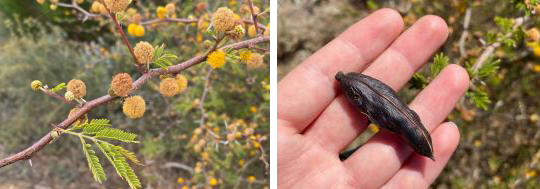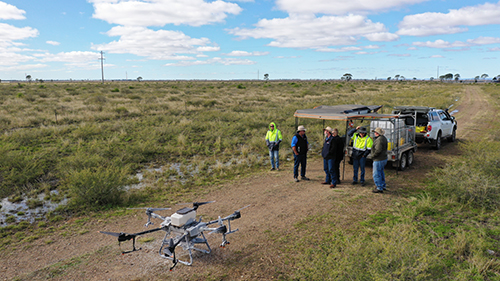Mimosa bush
Mimosa bush (Varchellia farnesiana) is a species of concern due to its ability to invade and threaten grazing, recreation, environmental and cultural uses on Travelling Stock Reserves (TSRs). Thriving in tropical, sub-tropical and warm temperate climates, and can grow alongside roadsides, water courses and seasonally inundated wetlands on a variety of soil types.
Once Mimosa bush becomes established, it dominates vegetation and becomes very difficult to control.
How to identify mimosa bush
Mimosa Bush is a branched, spiny perennial shrub growing to 6 metres in height with a taproot reaching a depth of 1-2 metres. It features:
- green and fern-like leaves, which are made up of many fine leaflets that occur in pairs along the branches
- large thorns (5-10 mm long) on the stem and smaller thorns on the branches between the leaves
- round, 1-2 cm diameter pink mauve flowers. Each flower head produces 10-20 olive green seed pods, which are 6-8 cm long and covered in fine hairs. Once mature, these pods turn brown and break into segments, containing oblong shaped seeds.

Left: Yellow flowers of Mimosa bush. Right: Mimosa bush seed. Images by NSW WeedWise.
Seeds are mostly spread by livestock and other animals that eat the fruit and spread the seeds in their dung.
Plants that look similar to Mimosa bush include karoo acacia (Vachiellia karroo), Mesquite (Prosopis spp.), Prickly acacia (Vachellia nilotica), Parkinsonia (Parkinsonia aculeata) or Cutch tree (Senegalia catechu).
Mimosa bush in the North West
Management options
In North West NSW, the highest densities are seen east and west of Moree. Mimosa Bush is a listed Invasive Native Species in the North West Local Land Services region under the Land Management (Native Vegetation) Code 2018, which means certain conditions must be met when controlling this plant.
These conditions are outlined in the ‘Land Management Code – Invasive Native Species’ Factsheet PDF, 1079.29 KB.
Common methods of control include:
- hand pulling seedlings or small plants
- mechanical control, although removing the root structure is difficult requiring this control option to be repeated within a few years
- fire, however plants will regrow from the roots
- chemical control, including spot spraying, basal barking, cut stump method or use of herbicide pellets.
Herbicides used include:
- Clopyralid 300 g/L (Lontrel®), PERMIT 14929 Expires 30/09/2029
- Tebuthiuron 200 g/kg (Various products), PERMIT 13891 Expires 31/05/2028
- Fluroxypyr 333 g/L (Starane™ Advanced)
- Triclopyr 240 g/L + Picloram 120 g/L (Access™)
To view permits or product labels go to the Australian Pesticides and Veterinary Medicines Authority website.
Work underway
Our staff have been hard at work controlling Mimosa Bush in North West NSW, particularly in the dense stands around Moree and Warialda. The TSR team are currently following up previous successfully treated patches and embarking on extending new treatment areas.

Drone photo of the TSR team spraying Mimosa bush.
Herbicide is spread via drone technology to control Mimosa Bush in the Moree, Garah and Pallamallawa areas.
Due to the results achieved, the team has also been developing case study videos for landholders about this trial project. Scott Graham, North West Local Land Services TSR Ranger takes us through the various methods of control used to tackle large infestations of mimosa weed at two different sites.
Outcomes of Mimosa bush treatment on Gwydir Highway, Moree
New control methods for Mimosa bush successful near Moree
More information
For further information or queries, please contact Local Land Services on 1300 795 299.
You can also read more about Mimosa bush and other priority weeds in your Regional Strategic Weed Management Plans or check out the NSW Department of Primary Industries Mimosa Bush web page.